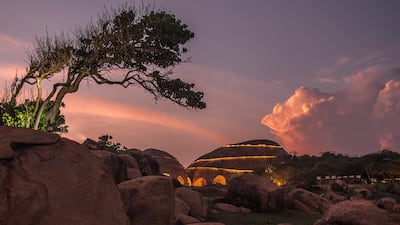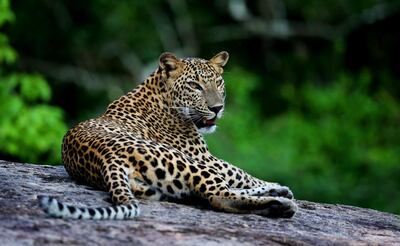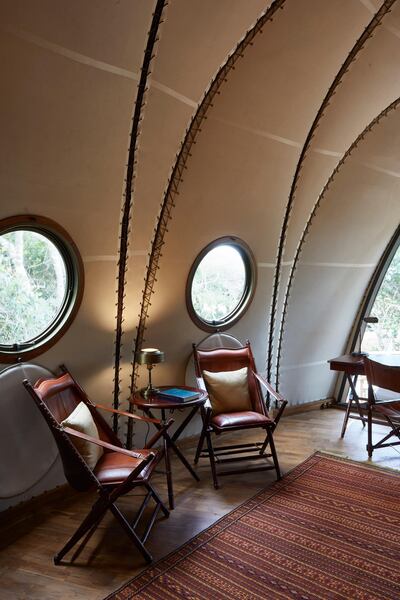As I set off on my first Sri Lankan safari, not only do I not think I will see a leopard, I am not entirely sure I want to.
I am in the 979-square-kilo-metre Yala National Park. Created in 1938 and divided into five blocks, only two of which are open to the public, the park has the densest leopard population in the world. Here, these apex predators are 30 per cent bigger than their African counterparts. Hence my trepidation.
The sun is high in the sky as we set out from the Wild Coast Tented Lodge, bumping along the park's dusty red roads. By the fifth elephant sighting, my fellow travellers and I feel like old hands. I see a mother elephant and her teenage daughter, as well as a newborn. I see peacocks dance and monkeys swing and crocodiles lying half-hidden in lagoons.
But none of these experiences prepare me for the leopard. Our guide – the youngest female international ranger in Sri Lanka – decides to head to an area of the park where a leopard had been spotted the day before. Her gamble pays off. As the leopard slinks out of the bush, she reminds me of my house cat: haughty, aware we are watching and taking all the time in the world to make her way to the watering hole. In that moment, I become a safari junkie.
While parks in Botswana, Kenya or Tanzania might be as big as Sri Lanka itself, Yala offers a more accessible experience for those who might want to try a safari closer to home. And, thanks to Sri Lanka's geographical location, many of the animals in Yala are subspecies, distinct from common Asian varieties.
For birders or nature enthusiasts, this means there are opportunities to see new kinds of animals. Or, as one local puts it: “Sri Lanka has the cutest elephants.”
The five-star Wild Coast Tented Lodge offers a novel way to sample Sri Lanka’s more rugged side. Guests stay in high-end yurts scattered through the jungle. Everything has been designed to blend into the natural environment. For example, meals are served in an area that, from the outside, looks like a large boulder. A Dali-esque saltwater pool snakes around the dining section and out on to the terrace and, from above, the hotel is shaped like a leopard’s paw.
The luxury lodge was designed by Nomadic Resorts – it was the company's first completed project and has garnered multiple awards.
With a full-sized copper bathtub and beautiful leather furniture, the yurts feel like they are straight out of Jules Verne's 20,000 Leagues Under the Sea. The sides are hand-stitched with the same material used in space suits – and no two are alike. "Our aim was to create a thermally comfortable environment which offered the same level of experience that you would get at a luxury hotel," says Louis Thompson, chief executive of Nomadic Resorts.
For eco-conscious travellers, these cocoons are a dream come true – about 50 per cent of their electricity comes from solar panels; they use desalinated water from the nearby Indian Ocean; and the runoff is pumped into a central watering hole. Although they are non-permanent structures, something that is important when building within a national park's buffer zone, once you are inside you would never know.
Admittedly, the layout is a bit compact – I overhear a few guests complaining about not having enough space to unpack their clothes – but the payoff is the feeling of living in a tree house. Nearly every side can be opened so that you feel like you're in the middle of the Sri Lankan bush, albeit with air-conditioning and plush bathrobes. The yurts were designed to enhance the environment, although plans did have to change slightly on account of the location. For one, the steel support beams had to be made larger in case elephants decided to use them as scratching posts, Thompson says.
Wild Coast is the brainchild of Malik Fernando, heir to the Dilmah tea company, and his brother Dilhan, and represents their third foray into the hospitality business.
As we speak at his offices in Colombo, Malik conducts an impromptu tea tasting for me, serving up to two brews in porcelain cups. Committed to creating family-run, intimate hotels with "fabulous" service, Fernando will wax poetic about any aspect of his properties, from how bamboo was stretched into Wild Coast's centrepiece bar, to the disease that afflicted the former coconut trees at Cape Weligama, his beachside property.
Falling under the umbrella of Resplendent Ceylon, the brothers' three unique properties are part of the Relais Chateaux family – a fact Fernando, who calls himself "the accidental hotelier", is clearly proud of.
He was managing the Dilmah plantations when he became entranced by some colonial-era tea bungalows in what he considered to be the most beautiful part of the country. In 2004, he began renovating them and, in 2005, opened Tea Trails.
The property was small – only five bungalows – but well-appointed. Sri Lanka's civil war had not yet ended, but in tea country there was an appetite for tourism. Business was brisk and, in 2009, they were invited into the Relais Chateaux family.
At the time, Fernando would receive letters from guests telling him how "unusual and interesting" the property was.
"And they used to write to me and say 'why don't you do something elsewhere because anywhere else we go after Tea Trails is a disappointment'," he recalls. For the entrepreneur, the next move was easy: the beach. The family already owned a former coconut plantation on the island's southern coast and, in 2014, opened Cape Weligama, a watersports resort that overlooks one of the south coast's acclaimed surf breaks.
Called the "tea, beach, safari" circuit, Resplendent Ceylon's trio of properties appeal to its clientele – Fernando says half of all guests complete the full circuit, especially ones travelling from North America.
Looking to the future, Fernando hopes to attract more clients from the Gulf – who now represent around 5 per cent of visitors – as well as India. Resplendent Ceylon intends to strengthen its offering with plans for a daily seaplane service from Colombo airport. A new property is also due in Sigiriya, the cultural triangle, in 2020, and a fifth is planned for Trincomalee.
Even after the Easter Sunday terrorist attacks on churches and hotels, Fernando remains undeterred, if a little frustrated. "They are grappling for solutions because this attack was entirely avoidable. There was a breach of communications," he says, referring to reports that officials had been warned about the attacks.
Under Fernando's leadership, a group of hoteliers came together to create The Sri Lanka Tourism Alliance, launching Love Sri Lanka (www.lovesrilanka.org) a week later. The crowdsourced site has the goal of "providing information and updates to assist with the rebuilding of confidence internationally. Arriving travellers can benefit from updates related to security, travel advice and 'on the ground' information from tourists and expats presently in Sri Lanka."
Although there have been subsequent attacks against Muslims in Negombo, Fernando believes these incidences are anomalies. "The attack was connected to global geopolitics, unconnected to any internal conflict," he says. "We've had 10 years of peace."
Back at the Wild Tented Coast Lodge, guests gather for sundowners and appetisers, in case anyone is feeling peckish after their afternoon tea, safari snack and lunch (in fact, it would be near impossible to ever feel peckish at Wild Coast). The way down to the rocks is lit with lanterns, and as the sea sprays in the distance guests are invited to settle down on beanbags or rugs. I gaze up at Orion's Belt and feel like I'm at the end of the world.
Safaris are great for making friends and this has the feel of a 1950s camp holiday, where everyone swaps stories of their adventures. After a few days here, everyone feels like a naturalist. On one 7am nature walk, a fellow guest hypothesises about boar hooves, while another discusses turtle eggs.
"People say Maldives, Maldives, Maldives," Fernando sighs. "Maldives is very one-dimensional. If you want to sit on a beach, that's OK; eat food like you're in London, that's OK. But if you want to connect to local communities, be among nature, safari and so on, which are all very accessible, Sri Lanka is the choice."





